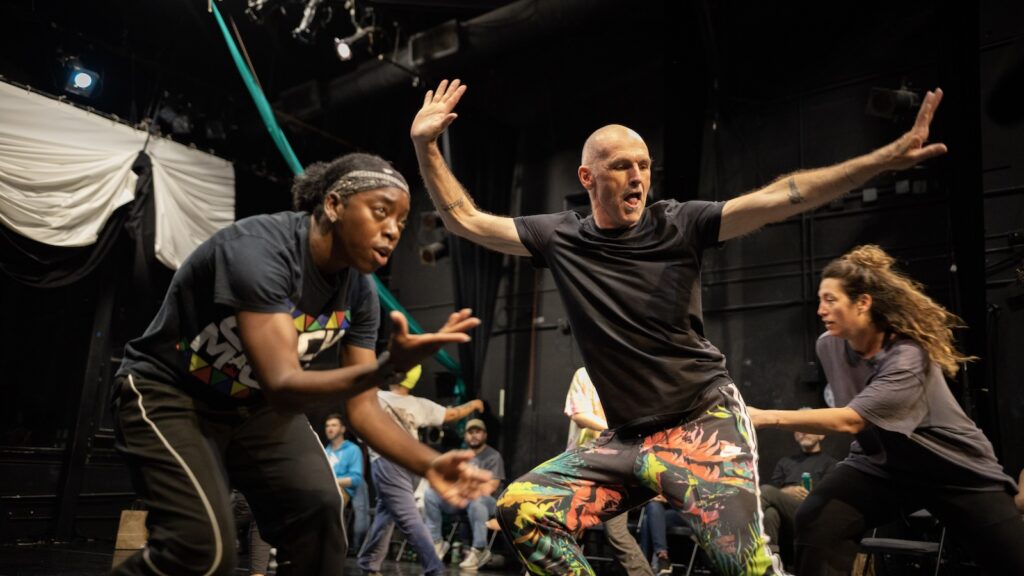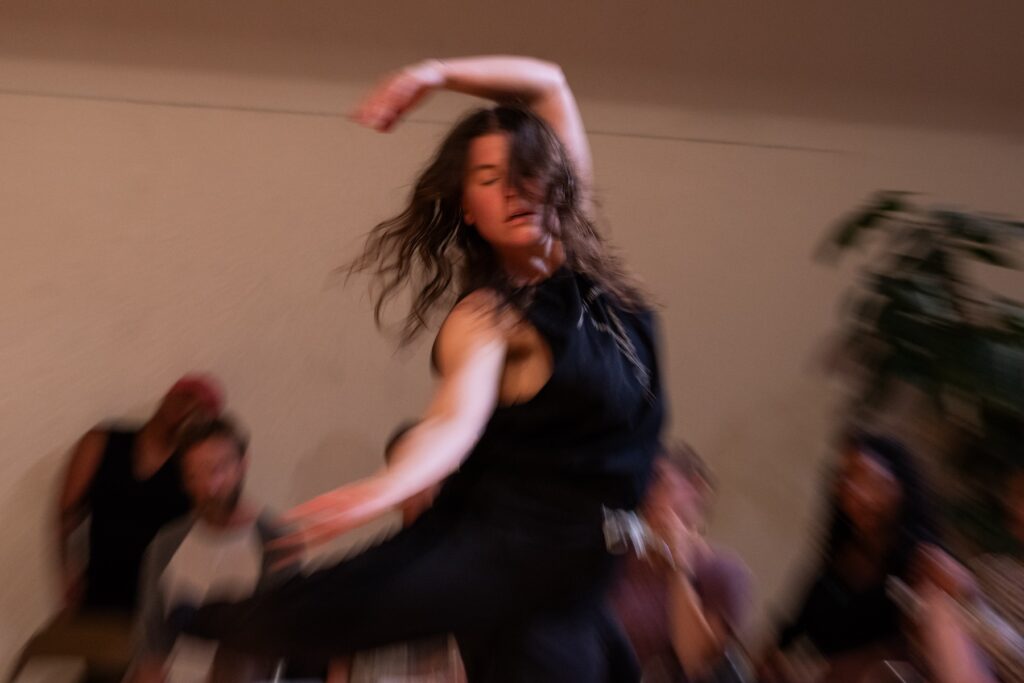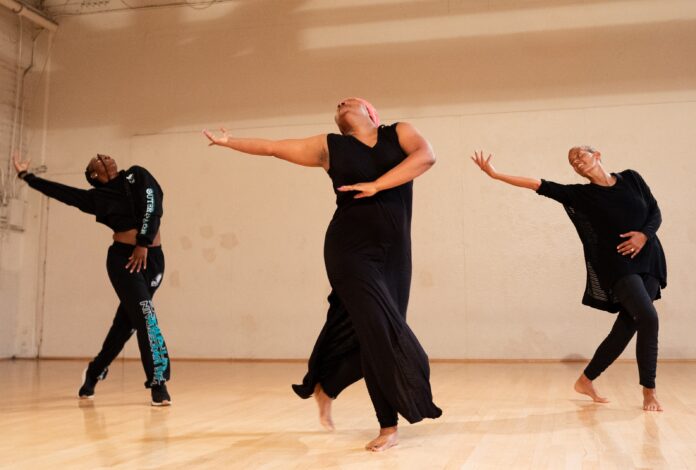The curtain speech for Tell (world premiere December 8–10 at Dance Mission Theater, SF) acknowledged not only the history of racist institutions, but also the fact the world currently seems to be in the middle of an ethnic cleansing spree (they explicitly alluded to Gaza, the Congo, and several other regions). After those acknowledgements, one of the dancers gave us a disclaimer: “We will not resolve any conflicts tonight,” she said, “but we will dance.”
The seems like a pretty low bar to clear, but that, sadly, is more than most Bay Area theatre troupes have said regarding those genocides (although Golden Thread and CounterPulse have taken great stands). It’s also a refreshingly realistic take on the power of art. We thrive on knowing our work can affect people in powerful ways, but that needs to be grounded in the fact that art isn’t a magic spell; it’s not likely to change anyone’s mind in one fell swoop, even if it does provide an epiphany.
Tell was borne from its creators’ desire to know what they don’t know and live with it. Its inception can be traced back three years to when co-creators Sarah Crowell (a biracial woman who identifies as Black) and Keith Hennessy (a queer white man) took part in the short film The Space Between Us. The film, which was shown in its entirety during Tell, features the two standing on opposite sides of an empty black box stage and place strips of tape in front of themselves. They then vent their frustrations with how they’re perceived by the outside world, in the hopes that the sharing would literally shorten the space between whatever barriers keep the two apart.
This led to a workshop in which the two hoped to recreate their experience with a larger group of collaborators. Crowell led the all-Black (and all-femme) half that included Samara Atkins, Sheila Russell, and Amber Julien; Hennessy was the only masc-bodied member of the white half with Larry Arrington, Ainsley Tharp, and Shaunna Vella. Through their rehearsals, they all grew comfortable enough with one another to be open about their insecurities the way Crowell and Hennessy were.

The result was shown to us gathered in Dance Mission: dialogue-free bursts of passionate contemporary dance (as well as projections and recitations of quotes from MLK, Audre Lorde, and more) broken up with anecdotes discussing the history of the piece itself. It began in the venue’s Studio 3, where folding chairs were arranged in the round (because, as Crowell explains, “Healing happens in a circle”) before eventually migrating all of us into Dance Mission’s proper theatre, where we watched the dancers use sticks and tape to make some sort of odd wooden effigy. All of this, believe it or not, was for the sake of healing racial divisions.
The dancing was always electrifying. It started with each member recreating the solo piece they showed each other when they first met as a group. It includes dancing to excerpts of Cynthia Erivo’s “Stand Up,” Nirvana’s “Smells Like Teen Spirit,” and Kendrick Lamar’s “DNA” before ending with the entire group dancing to A Taste of Honey’s “Boogie Oogie Oogie.” They separate into their original white and black groups, in which the members of those groups seem almost instinctually in tune with one another. Slowly, the group pieces and solo works merge all on stage like paperclips to a magnetic center. You’re never bored watching these people move.
The non-dancing came with mixed results. It’s illuminating hearing how all of this came to be and to witness it recreated (the white group started with an hilariously atonal chant of “This is so white”), but a few of the anecdotes could have gone by the wayside without losing anything in terms of the project’s energy. When it was good, it was really good, but there are moments when the performers seemed to be trying to fill the silence, particularly with building the effigy.

There was also a level of interactivity involved during which most audience members won’t know to expect. It began at the top with the audience taking part in the dancers’ physical warm-ups and continued with a midpoint exercise in which each dancer chatted with five to six members of the audience. I’m sure everyone loved the closing bow dance party, but it was far more fascinating to watch these folks explain and embody their journey towards mutual understanding; not so much to have to take part in it.
Help us save local journalism!
Every tax-deductible donation helps us grow to cover the issues that mean the most to our community. Become a 48 Hills Hero and support the only daily progressive news source in the Bay Area.
Opening night was Friday, December 8, delayed one week due to a COVID infection among an unidentified member of the cast or crew. KF94 masks are handed out at the check-in desk (which had three different air purifiers behind it), but they weren’t required. I wish they had been, as I was seated next to a youngster with a persistent cough. As with most old buildings, air flow is a challenge, with my Aranet4 reading CO² levels of 2272ppm in Studio 3, and up to 1233ppm in the theatre. Sadly, those aren’t the worst numbers I’ve seen since this still-ongoing pandemic began, but they consistently held my attention.
As we watched each powerful physical number from an array of body types, it’s intriguing to watch the individuals of the octet merge into a unified whole. At one point, an aerial rope elevates dancer Samara Atkins as she breaks down the group into a series of anonymous traits: some live in SF; some in Oakland; most identify as queer in some regard; one is a doctor; and all seem to be in one stage of marriage or another. “All of us find healing in the ocean,” she tells us, “and all of us chose to be in this piece.”
That connection was visceral throughout Tell, which—appropriately for a dance piece—was most palpable when it shows rather than, y’know, tells. It’s certainly one of the better dance pieces I’ve seen this year, though it could do with cutting back on the chatter. The piece is truly on fire when each dancer shows why they simultaneously love and hate living in their own skin.






